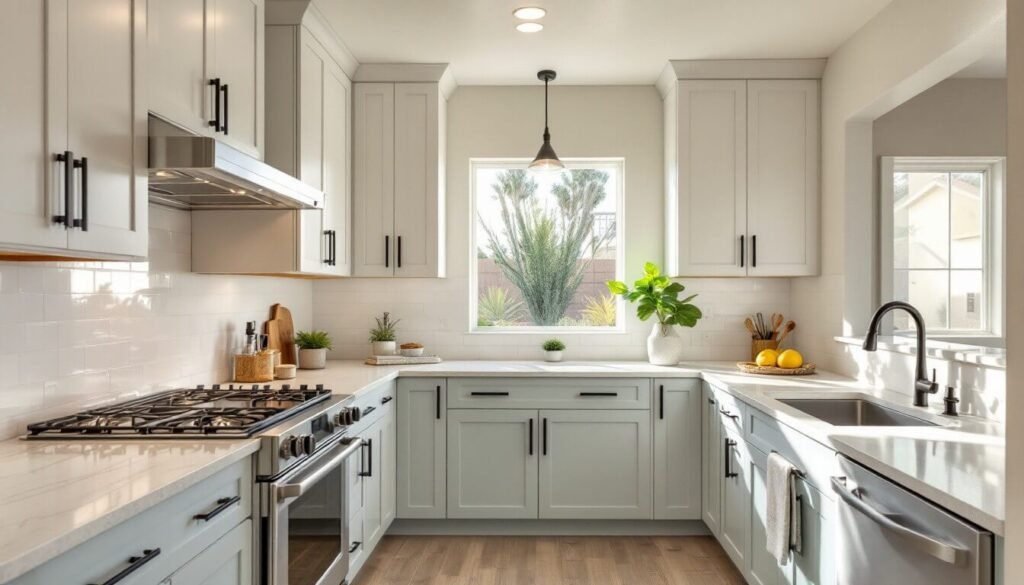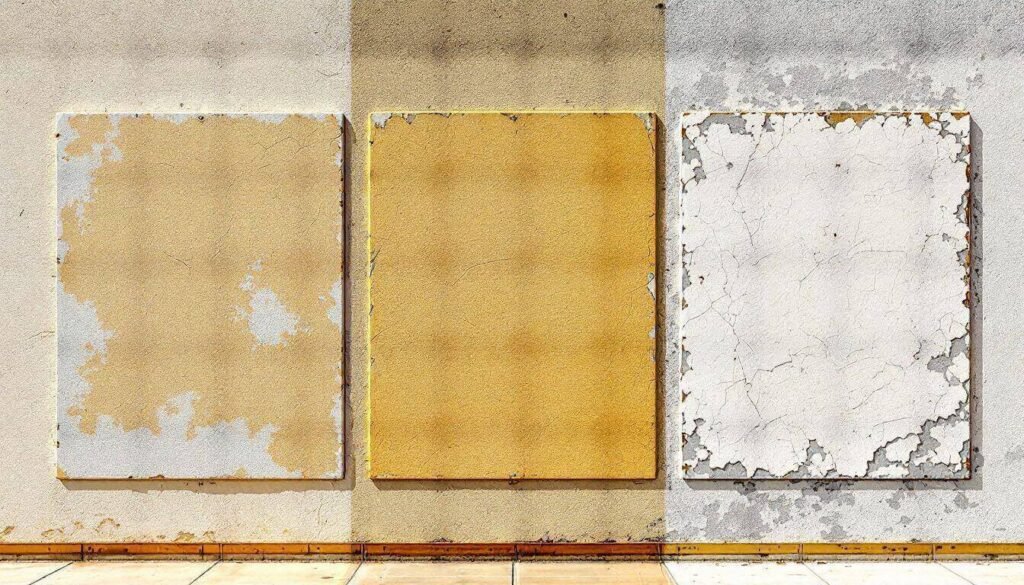How Often Should Commercial Buildings Be Repainted in Phoenix?
When Should Commercial Properties Be Painted in Phoenix?
Phoenix’s sun is no joke. With temperatures soaring above 100 degrees and sunlight beating down almost all year, building exteriors take a serious hit. For businesses, keeping up with exterior paint isn’t just about looks. It’s about protecting the building and making a good first impression on customers and clients.
- How Often Should Commercial Buildings Be Repainted in Phoenix?
- When Should Commercial Properties Be Painted in Phoenix?
- How Phoenix Climate Speeds Up Paint Wear
- Key Factors That Determine Repaint Timing
- Best Practices for Repainting and Maintenance
- Weighing Costs, Benefits, and Return on Investment
- Frequently Asked Questions
- Commercial Repainting Protects Your Investment
In this desert climate, painting is needed more often compared to other cities. Most commercial properties should expect to repaint every 5 to 7 years. That’s because strong UV rays break down paint fast, causing fading, cracking, and even damage to the building’s materials. The type of paint, how much shade a building gets, and what the surface is made of will all affect this schedule.
Regular repainting keeps your property looking sharp and can even help with maintenance costs over time. In this post, you’ll find out how the desert weather impacts exterior paint, signs it’s time to repaint, and tips for choosing the right products for Phoenix’s climate. You’ll also learn how to spot early damage, what paint lasts the longest, and why timing your repainting project can make a difference.
How Phoenix Climate Speeds Up Paint Wear
Phoenix’s desert climate brings year-round sun, towering temps, and dry air. These harsh elements chip away at even the best paint jobs. Buildings in this city face far more wear and tear than properties in cooler places. Understanding these local challenges can save your business money and headaches down the line.
Effects of UV Rays and Heat on Building Exteriors
The UV index often tops 10, which means sunlight attacks building paint every day. UV rays break apart the chemicals that hold paint together, known as binders. This makes the color fade fast and leads to peeling or flaking, sometimes within just a few years. Strong sun doesn’t just zap color; it also breaks paint’s chalky layer down to dust.
The desert’s heat is another big problem. Paint swells in the hot sun and shrinks overnight as temps drop. Over time, these daily cycles make paint brittle, which leads to cracks and chips. Shaded spots, like behind trees or awnings, hold onto their color and finish much longer.
Tip: Take a walk around your property. Think about your building’s south side, which faces the most sun. You’ll likely spot more fading, cracks, and peeling there than on walls in the shade.
Why Phoenix Differs from Cooler Regions
Phoenix is miles apart from cities like Seattle when it comes to paint longevity. Up north, paint may last 8 to 12 years before it even needs touch-ups, thanks to softer sun and fewer wild temperature swings. Phoenix buildings, on the other hand, often need fresh paint on the most exposed sides every 3 to 5 years.
The impact on businesses is clear. Faded wall colors, peeling trim, or dull and chipped signs can hurt your business’s first impression. Signs might lose their color so badly that customers can’t see your logo or name from the street. Maintenance costs add up quickly, with higher-frequency touch-ups needed to keep commercial spaces sharp.
Key difference: If you manage a commercial building in Phoenix, repainting simply can’t wait as long as it might in cooler climates. The city’s UV, heat, and drought make regular touch-ups a must for any owner wanting to protect both looks and value.
Key Factors That Determine Repaint Timing
No two commercial buildings in Phoenix age the same way. While climate shapes the overall lifespan of a paint job, three main factors play the biggest roles: what your building is made of, the type and quality of paint you use, and how much sun the property faces throughout the year. Owners who understand these influences can plan repaints more accurately and avoid unnecessary costs.
Impact of Surface Materials Like Stucco and Metal
Surface materials set the baseline for how long exterior paint will hold up in the Arizona heat. Stucco, common across Phoenix, usually keeps its color and finish for about 5 to 10 years if the prep work is solid. Its textured surface hides flaws well, but still loses protection quickest on the sunniest sides.
Wood, on the other hand, warps and expands as temperatures shift, stressing the paint and shortening repaint life down to 3 to 7 years. It is also much more vulnerable to water damage, even in the desert. Metal surfaces may look tough, but the valley’s intense heat can speed up rust and surface breakdown, especially on doors or trim. Exposed metal often shows wear fastest in the summer months.
For properties that use a mix of materials like stucco walls and metal storefronts, schedule regular inspections. Catching early warnings, like cracked caulk or peeling spots, can help spot trouble before it spreads.
Choosing the Right Paint for Longer Life
Not all paints perform the same under Phoenix’s triple-digit sun. Look for labels like UV-resistant or heat-reflective when buying, especially acrylic or elastomeric coatings. These paints are made to bend and flex with temperature swings without cracking or fading too quickly.
Premium paints may cost more at the start, but they hold their color longer, saving money on labor and materials over time. In short, cheaper paints can mean more frequent repaints and more touch-ups in the long run. The right product stretches your maintenance schedule and protects your investment.
Role of Sun Exposure and Building Location
Sunlight hits some surfaces much harder than others. South and west-facing walls, plus flat roofs, often need paint every 3 to 5 years because they soak up more daily UV. Parts of the building in shade, or protected by overhangs, might still look fresh after 7 or even 10 years.
It pays to check your building’s orientation and look for faded areas or brittle spots where the sun shines strongest. A site audit will reveal weak points and help plan a realistic repainting schedule based on exposure, not just a one-size-fits-all calendar.
Also, keep in mind that exposure patterns differ by region in this area. For example, Scottsdale’s luxury retail corridors and Tempe’s student-dense zones face unique challenges. Depending on the location, an area could have its own microclimate of sorts, adding to the factors that should be considered during the planning process.
Best Practices for Repainting and Maintenance
Staying ahead of maintenance can stretch the lifespan of your building’s paint and save money over the years. Timing matters for both appearance and protection. Phoenix’s weather is tough on exteriors, so it’s smart to keep a close watch and follow clear repainting steps. Here’s how to know when it’s time and what to do next.
Signs Your Commercial Building Needs a Fresh Coat
Spotting paint damage early prevents bigger, costly repairs down the line. In Phoenix, exposure to constant sun, wind, and dust leads to surface problems faster than in cooler places. Watch for these indicators that your building needs attention:
- Color dullness or fading: Paint loses its brightness, making the building look older.
- Flaking, peeling, or cracking: Visible breaks let water in, risking deeper damage.
- Water stains or marks: Discoloration signals that the paint’s protective seal is gone.
- Blistering or bubbling: Trapped heat or moisture makes paint lift away from walls.
Address problems when they start. Small repairs today help avoid full repaints and save you from structural issues down the road.
Steps for Effective Repainting in Phoenix
Proper repainting involves more than just rolling on a new color. Following a smart process gets the best results and helps each paint job last longer, especially in Arizona’s tough climate.
- Evaluate and Clean Surfaces
- Inspect for damage, peeling paint, or water issues.
- Pressure-wash exteriors to remove dust, dirt, and debris. Clean surfaces help new paint stick.
- Repair and Prep
- Patch cracks, holes, and any damaged areas.
- Use caulk on seams and joints. Scrape any peeling sections and sand glossy areas for better adherence.
- Choose the Right Paint
- Pick high-quality, UV-resistant paint or elastomeric coatings proven for use in intense sunlight.
- Don’t go cheap. Stronger paint cuts down on future work and holds color in the heat.
- Renovate in Cooler Months
- Plan repainting for fall or spring. Avoid summer because paint dries too fast in extreme heat, which causes cracks or bubbles.
- Skip the wettest times, too, so paint can cure properly.
- Hire Experienced Pros
- Commercial painting crews know Phoenix’s unique challenges and can finish on schedule without sacrificing quality.
- Routine Upkeep
- Clean your building’s exterior a few times a year to knock off dust and spot small issues.
Care now protects your property value, draws in new tenants or clients, and shows you care about your business’s appearance. Stick to these best practices, and Phoenix’s sun won’t have the final say on how your building looks or how long your paint lasts.
Weighing Costs, Benefits, and Return on Investment
Painting a commercial building in Phoenix is both a necessary expense and a smart investment. With the city’s heat and sun, property owners need to know what they’ll spend, what they gain, and how these decisions affect long-term costs and property value. Getting the numbers right can make a big difference in yearly budgets and long-term planning.
What to Expect: Cost Breakdown
Commercial repainting in Phoenix is more than just buying a few gallons of paint. The total price depends on building size, paint quality, surface issues, and labor. Most Phoenix property managers should plan for a cost between $1.50 and $7.00 per square foot. Exteriors alone typically range from $0.82 to $4.00 per square foot, while interiors can go slightly higher.
We know, those are big ranges, but there are many factors involved, like the type of surfaces being painted, required prep, how many coats will be applied, cost of materials, and much more.
Choosing top-of-the-line products or tackling complex surfaces (like multi-story buildings or lots of repairs) increases the price. Here’s a quick cost table for context:
| Space Type | Typical Cost per Sq Ft (2025) |
|---|---|
| Office Buildings | $2.00 – $4.50 |
| Retail Spaces | $2.50 – $5.00 |
| Warehouses | $1.50 – $3.00 |
Higher upfront costs for premium paint or skilled labor pay off with longer-lasting results and fewer repairs down the line.
Why Quality Matters: Key Benefits
Repainting is not just about looking good. The benefits reach well beyond the surface. Here’s what building owners gain:
- Enhanced curb appeal: A fresh coat makes your business stand out, attracting tenants and customers.
- Stronger weather protection: New paint acts as a shield against Phoenix’s sun, wind, and dust.
- Higher property value: Well-maintained buildings are valued higher and are easier to lease or sell.
- Lower long-term repair bills: Quality paint and proper prep slow down fading, peeling, and water damage.
Owners who cut corners may find themselves repainting sooner, multiplying expenses over time.
Simple ROI: What Do You Get Back?
Wondering if repainting pays for itself? Industry data shows exterior commercial painting returns about 55% of its cost in increased property value, with interiors climbing even higher. But the value goes beyond pure dollars.
Take a simple example: Say you repaint a 10,000-square-foot building exterior at $3.00 per square foot. That’s a $30,000 investment. If you get about 55% ROI, that means roughly $16,500 is added to your property’s value right away. Factor in protection from weather, lower maintenance costs, and an improved look, and the payoff keeps growing over time.
By tracking repainting as both a cost and an investment, building owners gain more control over budgets and upkeep. Spending more for quality now often means spending much less over the next decade.
Frequently Asked Questions
When planning commercial repainting projects in Phoenix, building owners and managers have many concerns. The desert climate is unique, and paint jobs need to be both durable and attractive. Below are answers to common questions we hear from those responsible for property upkeep in the Valley. These insights help you make smart decisions that protect both your building and your bottom line.
Commercial Repainting Protects Your Investment
Phoenix commercial buildings need a fresh coat of paint every 5 to 7 years to stay sharp and protected. The desert sun, heat, and dust will wear down even the best paint before you know it. With so much riding on curb appeal and property value, sticking to the right schedule makes all the difference.
Take action by scheduling a professional assessment if your property is due or showing signs of wear. Local painting experts can help set up a plan that is right for your specific building and surfaces.
Reliable maintenance means fewer headaches, lower long-term costs, and a building that impresses customers year after year. Thanks for reading.


